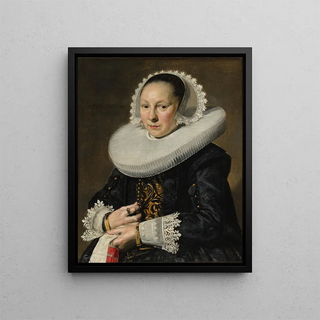Painting Portrait of a Woman Probably Aeltje Dircksdr Pater - Frans Hals | Art print


View from behind

Frame (optional)
The "Art print Portrait of a woman probably Aeltje Dircksdr Pater" by Frans Hals stands as an iconic work of the 17th century, showcasing unparalleled artistic mastery. Through this painting, Frans Hals, an undisputed master of portraiture, manages to capture not only the physical appearance of his subject but also an essence, a vibrant personality that transcends time. This piece, remarkable for its precision and expressiveness, invites viewers to delve into the intimacy of a frozen moment, revealing the complexity of human emotions. The woman's gaze, both direct and enigmatic, seems to tell a story—one of a bygone era but still alive in collective imagination.
Style and uniqueness of the work
Frans Hals's style is distinguished by its dynamic approach and unique painting technique. Unlike other artists of his time who favored rigid compositions and conventional poses, Hals adopts a freer and more spontaneous approach. In this art print, visible brushstrokes create a lively texture that gives an impression of movement. The play of light and shadow, carefully orchestrated, highlights the delicate features of the woman's face while emphasizing the richness of the fabrics surrounding her. This ability to convey life and depth of emotion through color and light is what gives this art print its unmatched singularity. Hals's mastery of tonal nuances and contrasts makes this portrait not only a representation but also a true exploration of the human psyche.
The artist and his influence
Frans Hals, born in Antwerp in 1582, is often regarded as one of the pioneers of modern portraiture. His career, spanning several decades, is marked by constant innovation and a desire to capture the individuality of his subjects. Influenced by the Flemish tradition while developing his own style, Hals established himself in the artistic landscape of his time. His portraits, often painted en plein air, are imbued with freshness and immediacy, giving them an almost lifelike dimension. Hals's influence is evident in subsequent generations of artists.

Matte finish

View from behind

Frame (optional)
The "Art print Portrait of a woman probably Aeltje Dircksdr Pater" by Frans Hals stands as an iconic work of the 17th century, showcasing unparalleled artistic mastery. Through this painting, Frans Hals, an undisputed master of portraiture, manages to capture not only the physical appearance of his subject but also an essence, a vibrant personality that transcends time. This piece, remarkable for its precision and expressiveness, invites viewers to delve into the intimacy of a frozen moment, revealing the complexity of human emotions. The woman's gaze, both direct and enigmatic, seems to tell a story—one of a bygone era but still alive in collective imagination.
Style and uniqueness of the work
Frans Hals's style is distinguished by its dynamic approach and unique painting technique. Unlike other artists of his time who favored rigid compositions and conventional poses, Hals adopts a freer and more spontaneous approach. In this art print, visible brushstrokes create a lively texture that gives an impression of movement. The play of light and shadow, carefully orchestrated, highlights the delicate features of the woman's face while emphasizing the richness of the fabrics surrounding her. This ability to convey life and depth of emotion through color and light is what gives this art print its unmatched singularity. Hals's mastery of tonal nuances and contrasts makes this portrait not only a representation but also a true exploration of the human psyche.
The artist and his influence
Frans Hals, born in Antwerp in 1582, is often regarded as one of the pioneers of modern portraiture. His career, spanning several decades, is marked by constant innovation and a desire to capture the individuality of his subjects. Influenced by the Flemish tradition while developing his own style, Hals established himself in the artistic landscape of his time. His portraits, often painted en plein air, are imbued with freshness and immediacy, giving them an almost lifelike dimension. Hals's influence is evident in subsequent generations of artists.
12,34 €






